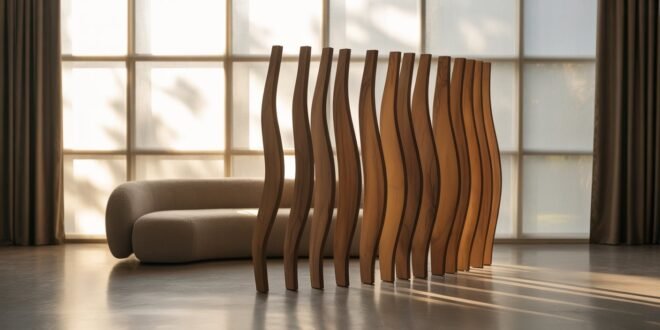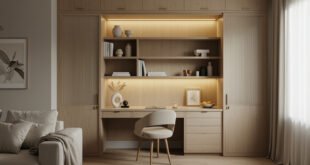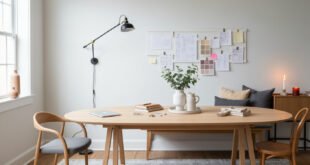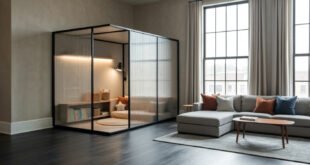Imagine sliding a single shelf into place and watching your studio bloom into two cozy rooms.
That little trick rescued me after one too many Zoom calls collided with taco night.
Stick around and you’ll pocket three wins: airy bookcase borders, fold-away screens, and a jungle-lush plant curtain.
No drills, no landlord side-eye—just renter-friendly fixes that keep light and flow alive.
Let’s kick things off by framing your zones with see-through shelving.
Frame Zones with Airy Open Shelving
Open-back shelves act like friendly fences. They split a sofa zone from a table zone without blocking daylight or chatter. In the next bits, you’ll learn how to dress both sides so the shelves feel planned, not random. You’ll also see tricks that keep sunshine dancing through every gap. By the end, you’ll know how an airy living room divider can store books, show off treasures, and still let the afternoon glow glide right on by. So grab a snack, and let’s style those shelves.
Style Both Sides for Double Impact
You get twice the view, so give twice the style. Face cookbooks toward the kitchen and art books toward the couch. Mix pretty and practical so nobody sees a “back.” Treat each side like its own tiny gallery. Ready to dial up the wow?




Use the 3-5-7 Rule
Odd numbers fool the eye in a good way. Three vases feel lively; four feels like math homework. Five staggered photo frames pull you in; six looks like a grid. Seven small plants? Pure jungle magic. The rule is quick, easy, and makes shelves sing.
Match Each Zone’s Colors
Pick colors already living in each side of the room. Warm bowls face the dining spot; cool prints face the sofa. That echo makes the divider feel custom. No paint brush needed. The shelf does the color talk for you.
Ground with Closed Baskets
Heavy baskets on the bottom stop tip-overs and hide mess. Toss in game controllers, spare chargers, or dog toys. The closed weave calms the eye. It also keeps dust from shouting “hello.” Style up top, stash down low.
Stagger Heights Creatively
High vase, low candle, mid-size frame—repeat. The up-and-down rhythm guides eyes across the shelf. No one object steals the show. It keeps the divider from reading like a wall of bricks. Think skyline, not staircase.
When both faces feel balanced, guests wander around the shelf like it’s a museum piece. You enjoy beauty from the couch, and dinner pals see charm from the table. One skinny footprint, two full stories. That’s double duty done right.
Quick tip: If you’re unsure where to start, empty the shelf first. Then add big pieces, fill gaps with medium, and sprinkle little treasures last.
Keep Light Flowing Through
Shelves can block or bless your daylight. Let’s bless it. Open frames, empty spaces, and shiny objects work like mini windows. They keep a studio bright while still marking zones. Here’s how to guard every sunbeam.


Pick See-Through Frames
Thin metal, wire, or skinny wood edges almost vanish. They draw a line without throwing shade. Your room stays bright, and the shelf looks lighter than air. Even thick books can’t dim that effect. Light wins.
Leave Space to Breathe
Resist the urge to stuff every cubby. About one-third empty spots lets rays slip through. The gaps also rest the eyes. More air means less dust. Win-win.
Mirror for More Light
Pop a small mirror or shiny pot on the shelf. It bounces rays into dark corners. A dull nook becomes bright without a lamp. Mirrors weigh little but work hard. Call it free sunshine.
Keep Heavy Items Low
Place the stone bowl down low, the glass swan up high. Low weight keeps balance and saves toes. Light goodies on top stay safe from curious pets. The divider feels steady, yet airy. Gravity thanks you.
Guard those peek-throughs and the shelf never steals glow—it frames it. Your tiny place stays cheerful all day. Plus, you can find lost socks because nothing lurks in the dark. Apartment living never looked so bright.
Pros & Cons: Open shelves give light and storage, but they also show dust. A quick feather duster once a week keeps the magic alive.
End note: Open shelving is the renter’s secret handshake. No drill, no holes, just lift, place, style, and enjoy. It holds books, frames space, and lets you move out without wall scars. A living room divider that leaves both landlord and sunlight smiling.
Slide In Flexible Folding Screens
Folding screens are like pop-up walls you can hide in a heartbeat. One moment they give privacy; the next they tuck behind a sofa. In this section, we’ll pick patterns that match your mood and see storage tricks that make screens vanish. They’re light, playful, and perfect when your lease says “no nails.” Let’s fold, unfold, and have fun.
Choose Patterns to Match Mood
Your screen is a giant art piece on hinges. It can whisper calm or shout party. Texture, print, and even see-through spots set the vibe. Let’s dress that panel for its big role.



Lean Into Texture
Woven cane, grass, or fabric feels cozy to the touch. It adds warmth a plain board can’t. Even flat rooms gain depth. You might find yourself petting the screen—no judgment. Texture invites hands and eyes.
Splash in a Print
Big leaves, bold shapes, or soft stripes turn the panel into wall-size art. Folded halfway, it still shows off. The print also hides smudges from roommate paws. You’ll smile each time you walk by. Art class, zero cleanup.
Play with Transparency
Rice paper or mesh blurs shapes but keeps light. You see light flicker, not clutter. It’s like privacy glass, only foldable. Great for zoom calls behind the couch. Bright and private—magic mix.
Go Monochrome for Calm
Solid black, white, or soft taupe melts into the room. It frames zones quietly. Add nearby pillows in the same shade for a chill aura. Calm beats chaos every time. Your nerves will notice.
Choose a pattern that cheers you on a rough Monday and still charms guests on Friday. A screen’s style sets the whole mood, no nail holes needed.
How to: Unsure of pattern? Test with a bed sheet first. Drape it over a chair in the color or print you like. Live with it a day. Love it? Buy the screen.
Fold Flat for Easy Storage
A screen should be strong on duty yet slim off duty. The right build folds like an accordion and slides beside a dresser. Let’s make storage a breeze.


Take Advantage of Accordion Action
Three or four connected panels collapse to a sliver. They slide between fridge and wall without a squeak. Quick fold means quick cleanups too. Company coming? Hide the laundry zone in ten seconds. Boom—tidy.
Pick Lightweight Materials
Plywood or bamboo keeps weight low. One person can lift, flip, or carry it. No scraped floors, no grunts. Your back sends thanks. Your downstairs neighbors enjoy less thud.
Add Casters for Wheels
Tiny wheels make the screen glide. A gentle push moves it from lounge to bedroom. Movie night? Roll it out as a headboard. Morning? Roll it back. Wheels equal freedom.
Store Upright to Prevent Warp
Keep the screen standing, not lying. Upright storage stops bending and weird creases. A narrow gap by the wardrobe works great. The screen stays ready for action. Lazy storage, smart result.
When a divider packs away this fast, your space can morph from study hall to dance floor in seconds. The screen waits in stealth mode until duty calls.
Pros & Cons: Screens give instant walls but don’t block sound. Pair with headphones if you need silence.
End note: Folding screens are the Swiss-army dividers of tiny homes. They move, hide, and return with style. No drill, no dust, all gain.
Grow a Lush Green Curtain of Plants
Think of a plant wall as a jungle hug that splits work from chill. It softens hard lines, filters air, and looks alive—because it is. We’ll first layer heights for deep texture, then add wheels so your leafy living room divider can roam. Grab a watering can; adventure ahead.
Layer Heights for Tropical Depth
Plants love friends. Short, tall, and trailing ones create a green waterfall. That depth turns a plain shelf into a mini rainforest. Let’s build the layers.



Start Tall then Taper
Place lofty palms or snake plants at the back. Mid plants fill the middle. Vines drape over the front like green ribbons. The eye travels from floor to ceiling. Height = drama.
Follow the Rule of Three
Group plants in threes or fives. It feels natural, like forest clumps. Even mismatched pots look planned. The brain likes odd numbers; let it be happy. Counting has never looked so lush.
Mix Leaf Textures
Pair broad leaves with feathery fronds and spiky blades. Each texture pops against the next. Guests lean in for a closer look. Touch is welcome, just watch the cactus. Variety keeps the display alive.
Leave Light Pockets
Skip a spot now and then so sunbeams slide between leaves. Plants grow stronger, and both rooms stay bright. Light holes also stop mildew. Your green wall breathes easier, so do you.
Layering turns simple pots into a living mural. You get privacy and an instant mood boost every time the leaves rustle.
Quick tip: Slip a moisture meter in one pot. It saves your plants—and carpet—from overwatering.
Wheel Planters to Reposition Zones
Need a quick room flip? Put plants on wheels. Your green curtain shifts with your plans, not against them. Let’s roll.


Choose Mobile Planter Walls
Big troughs on hidden casters move like a cart. Roll them in front of a messy desk at 5 p.m. Roll them back for game night. You’re the stage manager now.
Use Narrow Footprints
Slim planters guard space for feet and bags. They still give roots room to spread. Narrow means lighter too. Your floor sighs in relief. So does your vacuum.
Refresh Seasonally
Swap tulips in spring, lush vines in summer, evergreens in winter. The divider never looks tired. Friends think you hired a gardener. Only you know it’s a five-minute switch.
Protect Floors with Trays
Water drips happen. A tray and felt pads stop puddles and scratches. Slide, water, smile. Your landlord never knows.
A rolling garden offers privacy, fresh air, and endless rearranges. It’s a divider that grows with you—literally.
Pros & Cons: Plants clean air but need care. If you forget water for a week, pick hardy succulents instead.
End note: A green living room divider softens sound and mood. It’s renter-friendly, nail-free, and Instagram-ready. Let nature do the heavy lifting.
Float Soft Ceiling-Track Draperies
Curtains on tracks create a cloud you can pull open or closed. They hush echoes, hide clutter, and stack into a slim ribbon when not needed. First, we’ll draw sheer panels for cozy movie nights, then swap fabrics like outfits for each season. Your ceiling’s about to earn its keep.
Pull Sheers for Movie-Night Coziness
Sheers act like sunglasses for your space. They cut glare but keep the glow. They also turn a messy corner into a dreamy blur. Let’s hang them right.


Diffuse Daylight
Linen-like sheers scatter harsh sun. The room glows instead of glares. Your plants still cheer. Afternoon naps get softer. Win everywhere.
Add Sound-Dampening Layer
Hide a heavier panel behind the sheers. Close it for late films. Dialog stays in; hallway noise stays out. The combo feels like a private theater. Popcorn optional.
Run Track Wall-to-Wall
A full-length rail lets fabric park at the very ends. No bunching in mid-view. When open, the room looks wide. When closed, you get full coverage. Clean lines make happy eyes.
Keep Fabric Light Up High
Thin fabric weighs little, so stick-on tracks hold fine. No drilling means no deposit drama. Even one person can install it. Ceiling stays smooth, wallet stays full.
Sheers wrap your room in soft focus. Pull them closed, and the world hushes. Push them back, and daylight pours in. All gain, no holes.
How to: For faster glide, rub a dry bar of soap along the track. Smooth sailing every time.
Swap Fabrics with the Seasons
Curtains change like jackets—light in summer, thick in winter. Tracks make the swap easy. Let’s freshen up.


Summer vs Winter Fabrics
Gauzy cotton lets breezes swirl in July. Plush velvet traps warmth in January. One slide, new vibe. Even the cat feels the difference. Climate control never looked so chic.
Quick Track Hooks
Gliders pop off fast. Swap panels in minutes, not hours. No ladder drama. You’ll trade curtains as often as pillow covers. Easy is addictive.
Refresh Palette on Demand
New color, new mood. Bright coral wakes the room; deep navy calms it. Zero paint needed. Your landlord stays calm too. Curtains do the talking.
Curve Around Tricky Ceilings
Flexible rails bend around bulkheads. Fabric flows in one sweep. Awkward angles vanish behind soft folds. The room feels made-to-order. Your secret stays safe.
Seasonal swaps keep the divider fresh and the room comfy. It’s décor on a sliding scale—literally.
Quick tip: Store off-season panels in a pillowcase with a dryer sheet. They’ll smell fresh when their season returns.
End note: Ceiling-track drapes act like shape-shifting walls. They soften sound, light, and even awkward corners—all while keeping your lease squeaky clean.
Anchor Areas with Rugs and Pendants
No wall? No problem. A big rug underfoot and a shining pendant overhead outline space like invisible ropes. We’ll pair shapes above and below, then mix textures to hint at each zone’s job. Your open plan is about to feel organized, not chaotic.
Echo Shapes Above and Below
Match the light and rug, and magic happens. Circles talk to circles, rectangles to rectangles. The brain grabs the hint. Let’s make shapes team up.



Mirror Forms
Hang a round pendant over a round rug. It feels meant to be. No one questions the zone. Even pets know where to nap. Shape harmony for the win.
Size Pendant to Rug
Aim for a fixture half the rug’s width. Light reaches edges without glare. Too small feels lost, too big feels bossy. Half is the sweet spot. Math you can love.
Match Color Conversation
Pick one hue to echo from rug fibers to pendant shade. Maybe a brass glow meets beige threads. The echo ties pieces together. Guests see one island, not two strangers. Color whispers; eyes listen.
Center on Traffic Lanes
Line the pendant’s hook with the rug’s middle. Leave walking room around edges. No stubbed toes, no tangled wires. Flow stays smooth. You stay calm.
When shape and size play nice, zones announce themselves. Friends step onto the rug and know exactly where to plop down.
Pros & Cons: This trick won’t block noise, but it also won’t block rent returns. No holes, no hassle.
Mix Textures to Signal Function
Texture tells a story even with eyes closed. Soft means relax; firm means focus. Let’s weave that tale.



Layer Plush Over Flat
Shag under the sofa, flat weave under the table. Feet sink in one spot and scoot chairs in the other. You feel the switch without thinking. Texture is a silent sign. Simple yet smart.
Play Hard vs Soft
Velvet sofa meets jute rug meets metal lamp. Hard, soft, shiny—all chatting in balance. The mix keeps things interesting. Too much soft feels sleepy; too much hard feels cold. A trio warms the heart.
Let Rugs Hush, Lights Guide
Fibers soak up echoes. Pendant glow points at action. Together, they tame both sound and sight. Movie night is crisp yet comfy. Homework hour stays bright but quiet.
Try Tonal Twinsets
Two rugs in the same color family separate zones without a color clash. Think sand and caramel. Eyes read unity, feet read borders. Peace for everyone. Even the remote finds its home.
Texture layering bows to comfort and function at once. No walls, no problem—just cozy clues underfoot and overhead.
Quick tip: Use rug pads to stop slips and add extra hush. Your downstairs neighbors will never know your dance moves.
End note: Rugs and pendants draw lines only your senses can see. They split tasks without splitting square feet—a living room divider that’s all vibe, zero wood.
Craft a Sculptural Living Room Divider Feature
Some dividers don’t look like furniture; they look like art. Mirrors, curves, and moving panels can steal the show while still guiding foot traffic. First, we’ll bounce light with reflective tricks, then we’ll turn the divider into pure sculpture. Roll out the red carpet for your inner artist.
Use Mirrors to Bounce Light Deeper
Mirrors love sunlight and small spaces. Place them right, and rooms feel double in size. Let’s shine them up.



Pivoting Mirror Panels
A swivel mirror catches sun, then spins it across the room. Give it a gentle push to change the glow. It’s like a lighthouse for your couch. Bright spots land where you want them. Drama meets function.
Tall Reflective Screens
Full-height mirrored screens trick the eye into seeing more depth. Instant spaciousness without knocking down walls. They also reflect your coolest décor. Two birds, one reflection. Magic corridor effect engaged.
Lattice + Mirror Combo
Slatted wood in front of a mirror scatters tiny shards of light. You get sparkle, not glare. Shadows dance on the floor. It feels fancy but stays friendly. Light art in seconds.
Angle Reflections Wisely
Turn mirrors toward plants, art, or windows. You double the pretty stuff, not the clutter. Even a simple houseplant looks like a forest. Aim, admire, repeat. Easy spotlight.
Mirror dividers brighten, widen, and dazzle. They separate space while making it feel larger—talk about multitask power.
How to: If fingerprints bug you, keep a microfiber cloth tucked in a nearby drawer for quick swipes.
Highlight Divider as Room Art
Why build a plain wall when you can erect a sculpture? Let’s make the divider the star.




Pick Sculptural Panels
Curvy wood or resin panels cast cool shadows. They look like museum pieces. Friends ask, “Where’d you get that?” You shrug, feeling fancy. Art and divider in one.
Flex Curvy Softwalls
Paper or fabric softwalls bend into waves. They absorb noise and roll up small. Set them straight today, wavy tomorrow. Mood swings welcome. The room feels alive.
Treat Screens Like Canvases
Paint, embroider, or stencil a folding screen. It becomes a movable mural. Rotate it for a fresh view. Blank wall? None in sight. Your art class gets applause.
Bring in Kinetic Elements
Panels that spin or slide change views as you walk by. Shadows shift, curiosity rises. Kids and pets get free entertainment. So do you. Interactive art rocks.
Frame Negative Space
Dividers with peek-through cutouts keep sightlines open. Light pours in, yet zones stay marked. The gaps look graphic, almost comic-book cool. Less material, more style. Win on every level.
A sculptural living room divider does triple duty—wall, art, and conversation starter. Your home feels like a gallery that you also happen to nap in.
Pros & Cons: Showpiece dividers wow guests but may cost more effort to move. Plan a helper for big shifts.
End note: Treat the divider as art, and you never resent the space it takes. Instead, you brag about it. Light, shade, and style join forces, all while keeping your lease intact.
You’ve now toured shelves, screens, plants, curtains, rugs, lights, and sculptures—each a living room divider that sneaks in style without angering your landlord. Pick one or mix a few. In every case, walls stay nail-free, space stays bright, and life in a small pad feels a lot bigger. Happy dividing!
Conclusion
Your new living room divider isn’t just a barrier—it’s the secret sauce that lets one room pull double duty with style.
- Breathable open shelving stores books and dinnerware while carving out calm.
- Fold-flat screens swing from privacy to party mode in seconds.
- Leafy plant curtains clean the air and create an indoor oasis.
Grab a tape measure, map your walkway, and test one idea this weekend.
Which divider dream are you eyeing—sleek shelves or a green wall? For even more inspo about Living room divider, hop over to our Pinterest board on Living Room Layouts and start pinning!



